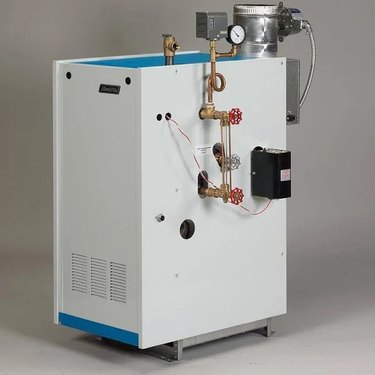A boiler is a heating system that uses water — not air — to heat indoor air. Unlike the more common forced-air systems, boilers have been around since the 19th century, and these hot water heating systems are surprisingly energy efficient when they are working properly.
Parts of a Boiler
Video of the Day
Boilers heat water, which in turn circulates throughout your home to keep it warm. In order to create that heat, a boiler needs a fuel source, which today is usually oil or natural gas. These efficient heating systems also have several working parts.
Video of the Day
Boilers need a burner, a combustion chamber, a heat exchanger, an expansion tank, an aquastat, a safety relief valve and a low-water cutoff. The heat source, which is probably going to be oil or gas, enters the burner, funneled in from the fuel tank. The combustion chamber is where the fuel is burned with just the right proportions of air and fuel.
The hot gases are directed to the heat exchanger, where heat is transferred from the fuel source to water through the process of conduction. The hot water is transferred to pipes that circulate the water throughout your home. The expansion tank absorbs the natural property of temperature and pressure rising and falling respectively to maintain safe operating pressures.
A Circular Process
A boiler system doesn't stop working once the hot water leaves the furnace and travels through the pipes. The fuel that heated the water is vented out of the house using a chimney or other venting system. This prevents carbon monoxide buildup.
A hot water system once relied on gravity to propel the water from the boiler in the basement into the house. The lighter, warmer water rose into the house through pipes, while the colder, heavier water was piped back to the basement. Electrical circulator pumps, which came about in the 1920s and 1930s, made that job easier.
Once hot water has warmed the radiators, it is piped back to the boiler, where the warming process begins again. There are other controls in place, however, to make sure that the water temperature, air and fuel supply mixtures, ignition and internal pressure are right.
Other Safety Parts
The other working parts of your boiler are there to ensure your boiler is working properly. The aquastat is like a thermostat. Its job is to make sure the water temperature is between 160 and 180 degrees Fahrenheit.
The safety relief valve opens and releases water if the pressure gets too high inside the boiler. The low-water cutoff makes sure the boiler doesn't run too low on water or shuts off the system if it does to prevent damage. A float or electronic probe is used to check the water level and trigger the fuel shutoff valve if it gets too low.
All these working parts must be properly maintained. You should have your boiler system and chimney checked annually to make sure all parts of the boiler continue to work properly and that your chimney is safe.
